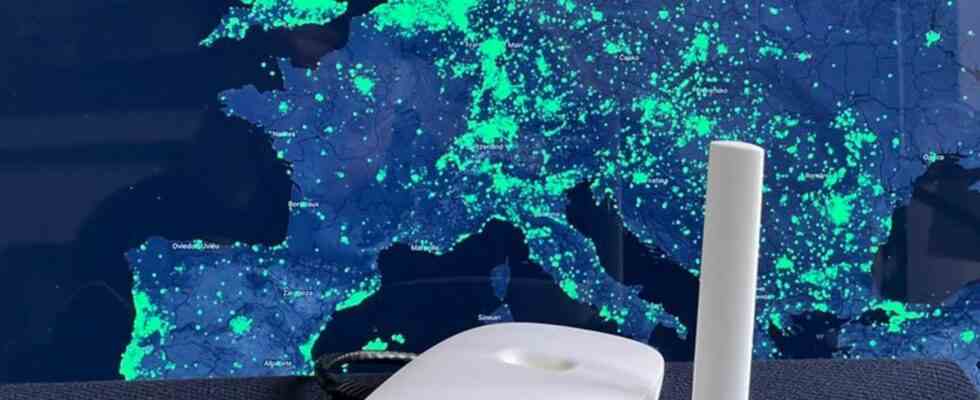network world
Join-in network Helium attracts users with cryptocurrency
A wireless hotspot of the Helium network in front of a network coverage map in Europe. Photo: Christoph Dernbach/dpa
© dpa-infocom GmbH
The billion-euro business with the “Internet of Things” has so far been divided among themselves by large telecommunications providers. But with the helium network, there is serious competition.
The “Internet of Things” is in a gold rush mood. According to estimates by market experts, over 15 billion euros were spent last year alone to network everyday objects with the Internet and with each other.
The spectrum ranges from smart collars for dogs to drinks vending machines to a shipping container, from networked street scooters to a heating thermostat to a sensor in a public rubbish bin that reports independently via radio when it needs to be emptied.
But the golden future is yet to come. While the potential of new smartphone contracts for human users is slowly being exhausted, the growth curve for the “Internet of Things” (IoT) is pointing steeply upwards. Annual growth of 20 percent and more is expected. In the meantime, not only conventional telecom providers are vying for the future market, but also new players. Unlike Telekom or Vodafone, they are not looking for luck on the licensed radio waves of LTE and 5G, but in the free frequency spectrum of 868 MHz. For the “LoRaWAN” (Long Range Wide Area Network), which can cover distances of several kilometers, no radio licenses have to be bought at auction.
Napster founder stands behind Helium
The helium network is growing most rapidly in this area. The San Francisco company Helium Systems was co-founded by Shawn Fanning, who brought the music industry to the brink of collapse with Napster in the early years of the Internet. Similar to the music file-sharing service Napster, Fanning did not rely on centralized structures for Helium, but on the power of the decentralized masses. Most of the gateways that connect Helium’s radio network to the Internet are not operated by partner companies, but by private individuals. That’s why Helium confidently describes itself as “The People’s Network”.
But why should volunteers join Helium? The answer is simple: money. The network lures the competitors with tokens of the cryptocurrency HNT. It can also be exchanged for dollars or euros. For an HNT token you currently get around 20 euros.
When “mining” HNT, energy-hungry arithmetic operations are not required to maintain the system, as is the case with Bitcoin. A helium gateway needs no more electricity than an energy-saving lamp. You also need an internet connection. On the one hand, the gateway operators are rewarded for the mere network coverage (“Proof of Coverage”). In addition, they share in the proceeds that commercial customers of Helium such as the scooter company Lime pay for the transport of their data.
650,000 hotspots in 164 countries
The prospect of a steady flow of revenue has sparked a run on helium in recent months. The network now consists of more than 650,000 hotspots in around 47,000 cities and 164 countries. Compatible gateways, which cost around 500 euros, are currently almost sold out. Small remaining stocks are offered at horrendous prices on Ebay, which in most cases make helium mining unprofitable. Large cities such as New York, London or Berlin are now so well covered that the voluntary miners are competing with each other – which depresses the income for each individual. In good peripheral locations without much competition, on the other hand, HNT tokens worth 20 euros a day or more can be achieved.
The potential of helium has meanwhile gotten around not only among private individuals who definitely don’t want to miss out on the next big thing in the crypto scene. Venture capitalists and commercial network operators are also electrified. Well-known names such as Khosla Ventures, First Mark Capital, Munich Re Ventures and GV (formerly Google Ventures) are on board as investors in Helium.
In Germany, the Düsseldorf transmitter network operator Uplink Network has discovered the new network for itself. The company actually mainly operates antennas and transmitters for radio broadcasting. In the meantime, however, Uplink also looks after helium gateways and antennas and offers complete solutions for radio data transmission projects.
Cheaper data transfer
Uplink boss Michael Radomski hopes that role models from abroad will also set a precedent in Germany. In Amsterdam, for example, Schiphol Airport uses LoRaWAN technology to track baggage and goods. In Lyon, visitor flows in museums and department stores are measured with it. And in Schaffhausen in Switzerland, the city administration uses the technology to control parking spaces. The LoRaWAN network Helium is significantly cheaper than data transmission with classic mobile communications. “We are helping to ensure that access to the helium network can be used more cheaply and easily,” says Radomski.
Traditional mobile operators don’t want to hand over the Internet of Things to companies like Helium or Uplink without a fight. Hannes Ametsreiter, head of Vodafone Germany, sees his company in a good position to compete: “The number of machines, robots and sensors that we network is increasing by more than 20 percent every year. More than 140 million objects are already transmitting in our network.» As an international telecommunications group, his company can therefore offer global services on the Internet of Things. This is of great importance, for example, for logistics companies that network containers or packages. “Licensed networks bring maximum quality and the highest possible security to the Internet of Things.”

